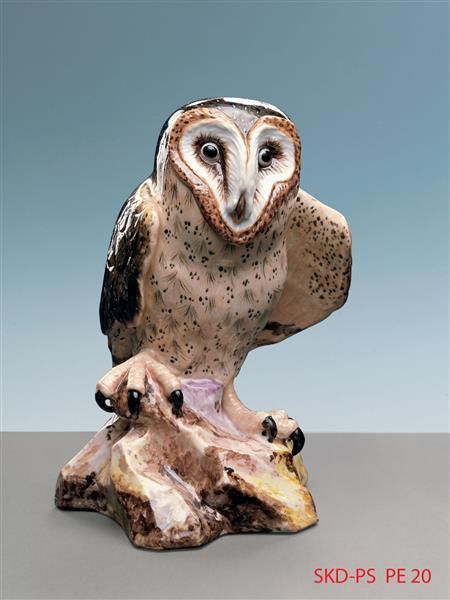Barn Owl
Barn Owl, Johann Joachim Kaendler (modeller), Meissen, 1731. Porcelain, enamel colors. H. 25.4 cm, W. 16.5 cm. PE 20. Porcelain Collection. © Staatliche Kunstsammlungen Dresden 2013
Shortly after joining as a modeller in the Meissen porcelain factory in 1731, the sculptor Johann Joachim Kaendler created a number of animal sculptures for the Japanese Palace. Kaendler made in a very short time with the unfamiliar material so familiar that he could easily create a series of life-size porcelain animals. His models looked Kaendler either directly in nature in front of the live animals in the menagerie of the Moritzburg hunting lodge or in the royal chamber in front of the natural history specimens. Thus, the study of nature was one of the most important prerequisites for Kaendlersche animal sculpture, whose life-like appearance of the modeller understood to be converted into the late Baroque art form by the powerful dynamics of the characteristic motifs of movement. In these early animal figures, there was also the barn owl, which was created in 1731. The painting of the great animal figures in the early thirties of the 18th Century faced serious problems. Large format sculptures survived the glaze firing seldom without tears, so after re-firing the enamel colors, the risk of further cracks was given. The buyer wish coloring of animals for the Japanese Palace was therefore rarely realized. In the barn owl but this already succeeded just perfect because of the relatively small size by the large dark eyes and brown feathers of the wings are on the underside of the bird in nice contrast to the bright fuzz of fine feathers. From this model, it seems to have only been two forms. One of these is the war losses of the porcelain collection.

/https%3A%2F%2Fprofilepics.canalblog.com%2Fprofilepics%2F1%2F0%2F100183.jpg)
/https%3A%2F%2Fstorage.canalblog.com%2F03%2F02%2F119589%2F96711876_o.jpg)
/https%3A%2F%2Fstorage.canalblog.com%2F11%2F31%2F119589%2F94773502_o.jpg)
/https%3A%2F%2Fstorage.canalblog.com%2F20%2F83%2F119589%2F94772815_o.jpg)
/https%3A%2F%2Fstorage.canalblog.com%2F26%2F72%2F119589%2F75604929_o.jpg)
/https%3A%2F%2Fstorage.canalblog.com%2F59%2F60%2F119589%2F26458628_o.jpg)



/http%3A%2F%2Fstorage.canalblog.com%2F28%2F56%2F119589%2F129494680_o.jpg)
/http%3A%2F%2Fstorage.canalblog.com%2F04%2F81%2F119589%2F128791640_o.jpg)
/http%3A%2F%2Fstorage.canalblog.com%2F73%2F16%2F119589%2F128381257_o.jpg)
/http%3A%2F%2Fstorage.canalblog.com%2F28%2F03%2F119589%2F126225626_o.jpg)